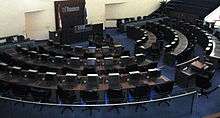Hemicycle




In legislatures, a hemicycle is a semicircular, or horseshoe-shaped, debating chamber (plenary chamber), where deputies (members) sit to discuss and pass legislation. Though composed of Greek roots, the term is French in origin.
Usage
The circular shape is designed to encourage consensus among political parties rather than confrontation, such as the Westminster system, where the government and opposition parties face each other on opposing sets of benches. The design is used in most European countries (and hence was adopted by the European Parliament) and the United States.
The United Kingdom, as the originator of the Westminster system, does not. However, two of the three devolved legislatures, the Scottish Parliament and Welsh Assembly, use hemicycles. The Northern Ireland Assembly does not use a hemicycle format.
Arrangement
In the case of Australia (see below), the two largest parties are still facing each other, whereas in the Scottish Parliament's hemicycle, the largest party sits in the middle. However, some hemicycles follow a strict left-right arrangement with, for example, a left wing governing party sitting on the left and the right wing opposition on the right. In these cases election results are often portrayed in the hemicycle to show the results of left wing or right wing coalitions (reaching 50% in the centre, where centrist third parties are located) for forming a majority.
Alternatives
Some Westminster system countries outside the UK, such as India, New Zealand and Australia, have confrontational benches, but the end segment is curved to create a partial hemicycle, while other countries, such as the People's Republic of China, have one set of benches facing towards a stage area (though this reflects the one-party system in operation there).
 The British House of Commons with its Westminster-style benches (old chamber shown)
The British House of Commons with its Westminster-style benches (old chamber shown) The Australian House of Representatives, a form of hybrid
The Australian House of Representatives, a form of hybrid The Chinese National People's Congress, benches facing a stage
The Chinese National People's Congress, benches facing a stage
Gallery
 Toronto City Council Chambers
Toronto City Council Chambers- Hong Kong Legco Chambers
See also
- The Hemicycle, the ceremonial entrance to Arlington National Cemetery
- Detail on the European Parliament's hemicycle
- Westminster style chamber
| Wikimedia Commons has media related to Hemicycles. |